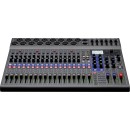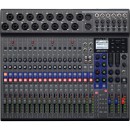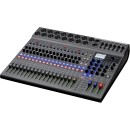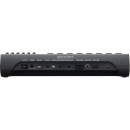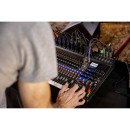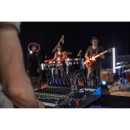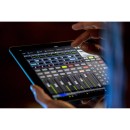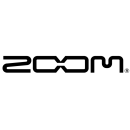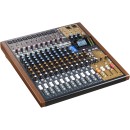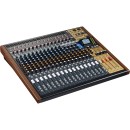Zoom LiveTrak L-20 Digital Mixer Multitrack Recorder Comprehensive Review
- 20 discrete channels, including 16 mono and 2 stereo inputs.
- Up to 22 tracks of simultaneous recording with 24-bit/96 kHz quality.
- Mix, monitor, and record all at once with an intuitive interface.
- Customizable headphone mixes with 6 monitor outputs.
- Built-in effects such as reverb, delay, and chorus.
- Save up to 9 scenes for easy recall of settings.
- USB audio interface capability for DAW integration.
- SD card slot for direct recording and playback.
- Bluetooth compatibility for wireless control via app.
- Flexible routing options with assignable outputs.
In-Depth Analysis of Zoom LiveTrak L-20 Features
The Zoom LiveTrak L-20 Digital Mixer Multitrack Recorder is a comprehensive solution designed for musicians and audio professionals seeking a versatile mixing and recording platform. With its intuitive interface and robust features, the L-20 offers the ability to mix live sound while simultaneously recording up to 22 individual tracks. This makes it an ideal choice for live performances, studio sessions, and rehearsals.
One of the standout features of the LiveTrak L-20 is its ability to manage complex audio setups with ease. It boasts 20 discrete channels, including 16 mono channels and two stereo channels, each equipped with its own 3-band mid-parametric EQ and 20 built-in effects. The mixer also provides six customizable monitor outputs, allowing performers to tailor their own mixes for optimal sound quality and clarity during live performances.
In addition to its powerful mixing capabilities, the Zoom LiveTrak L-20 excels as a multitrack recorder, enabling users to capture high-resolution audio directly to an SD card. It supports up to 24-bit/96 kHz recording, ensuring professional-grade audio fidelity. Furthermore, the L-20 can function as a 22-in/4-out USB audio interface, seamlessly integrating with popular DAWs for further editing and production work. This versatility makes the LiveTrak L-20 a valuable asset for any audio setup.
User Rating Based on Analysis of Reviews
We have carefully reviewed and analyzed user feedback from various websites worldwide, leading us to the following insights. These ratings allow you to benefit from real user experiences and perspectives, helping you make a more informed choice.
Purchase Value
85% of users felt that the Zoom LiveTrak L-20 offered excellent value for money. They praised the device for providing a wide array of features typically found in higher-end models, but at a more accessible price point. Users were particularly impressed with the combination of digital mixing capabilities and multitrack recording, which made it an attractive option for both live performances and studio recordings.
15% of users expressed dissatisfaction with the purchase value, primarily due to the perception that the device lacked certain advanced features available in more expensive models. They also mentioned that the initial setup and learning curve were steeper than expected, which detracted from the overall value proposition.
Quality of Materials
80% of users were satisfied with the quality of materials used in the construction of the Zoom LiveTrak L-20. They appreciated the robust build and durable design, which made it suitable for frequent transportation and use in various environments. The solid feel of the knobs and faders was frequently highlighted as a positive aspect.
20% of users were less impressed with the material quality, noting that some components felt less sturdy than expected. There were concerns about the longevity of certain parts, such as the faders and knobs, which were reported to feel slightly flimsy after extended use.
Ease of Use
75% of users found the Zoom LiveTrak L-20 relatively easy to use once they became familiar with its interface. They appreciated the intuitive layout of controls and the clear labeling, which facilitated quick navigation during live sessions and recordings.
25% of users experienced difficulties with the ease of use, citing a steep learning curve and a lack of comprehensive instructional resources. These users felt that the interface could be more user-friendly, with some suggesting that the manual did not adequately cover all functions.
Sound Quality
90% of users were highly satisfied with the sound quality provided by the Zoom LiveTrak L-20. They reported clear, professional-grade audio output, with minimal noise and distortion. The built-in effects and EQ options were also praised for enhancing sound production capabilities.
10% of users were less satisfied with the sound quality, mainly because they encountered issues with noise interference in certain settings. Some users felt that the effects were limited in comparison to standalone units or more specialized equipment.
Portability
88% of users appreciated the portability of the Zoom LiveTrak L-20, noting its compact size and lightweight design. This made it particularly appealing for musicians and sound engineers who needed to transport the device regularly for gigs or sessions.
12% of users expressed concerns about portability, particularly due to the need for careful handling to avoid damage. Some users also mentioned that the inclusion of a carrying case would enhance its portability.
Reliability
82% of users were satisfied with the reliability of the Zoom LiveTrak L-20, reporting consistent performance in various settings. They valued the device's ability to handle demanding audio tasks without crashing or malfunctioning.
18% of users experienced reliability issues, including occasional software glitches and connectivity problems. These users felt that firmware updates could improve stability and address some of the common issues encountered.
Versatility
91% of users praised the versatility of the Zoom LiveTrak L-20, appreciating its dual functionality as both a mixer and a recorder. They found it adaptable for different applications, from live sound mixing to studio production.
9% of users felt that the versatility was somewhat limited, particularly in terms of advanced recording features. Some users expressed a desire for more inputs or outputs to accommodate larger setups.
Customer Support
77% of users were satisfied with the customer support provided by Zoom, noting prompt and helpful responses to their inquiries. They appreciated the availability of online resources and community forums for additional help.
23% of users were dissatisfied with customer support, citing long response times and inadequate solutions to their problems. Some users felt that technical support staff lacked the expertise needed to resolve complex issues effectively.
Durability
84% of users reported satisfaction with the durability of the Zoom LiveTrak L-20, mentioning that it withstood regular use without significant wear and tear. The device was frequently described as 'built to last,' even in demanding environments.
16% of users had concerns about durability, mainly due to issues with certain components breaking down over time. There were specific mentions of faders and knobs becoming less responsive or loose after extended use.
Recording Quality
89% of users were impressed with the recording quality of the Zoom LiveTrak L-20, highlighting its ability to produce clean, high-fidelity recordings. The separate track recording feature was particularly appreciated for its flexibility in post-production.
11% of users found the recording quality lacking in certain situations, experiencing minor issues with latency and synchronization. Some users also wanted more advanced editing features to be integrated into the device.
User Interface
78% of users found the user interface to be generally intuitive, with controls that were easy to access and adjust on the fly. They appreciated the logical organization of the interface, which facilitated quick learning.
22% of users felt that the user interface could be improved, mentioning that it was not always intuitive for beginners. There were calls for a more streamlined design and clearer labeling to help users navigate the device more efficiently.
Software Integration
76% of users were satisfied with the software integration capabilities of the Zoom LiveTrak L-20, noting that it worked well with popular DAWs and recording software. The ease of file transfer was frequently mentioned as a positive feature.
24% of users experienced issues with software integration, including compatibility problems with certain DAWs and difficulties in syncing the device with other software. Some users expressed a desire for more seamless integration and additional software support.
Flexibility
87% of users valued the flexibility of the Zoom LiveTrak L-20, particularly its ability to adapt to different audio scenarios such as live events, studio sessions, and podcasting. The multiple input and output options were highlighted as key benefits.
13% of users found the flexibility to be somewhat limited, particularly when it came to more complex setups requiring additional routing options. Some users felt that the device could benefit from more customizable features.
Battery Life
70% of users were content with the battery life of the Zoom LiveTrak L-20, especially when used in settings with reliable power sources. They appreciated the device's power efficiency during long sessions.
30% of users were dissatisfied with the battery life, noting that the device required frequent charging or a constant power supply, which limited its use in remote or outdoor settings. Some users recommended the addition of a longer-lasting battery or alternative power options.
Design
83% of users were pleased with the design of the Zoom LiveTrak L-20, describing it as sleek and modern. They found the layout to be ergonomic and conducive to efficient operation, even during extended use.
17% of users felt that the design could be improved, particularly in terms of the placement of certain controls. Some users found the design to be somewhat cluttered, which made it challenging to operate the device quickly and accurately.
Connectivity
81% of users were satisfied with the connectivity options provided by the Zoom LiveTrak L-20, appreciating the variety of inputs and outputs that accommodated different equipment and setups. The ease of connection to other devices was also noted as a positive feature.
19% of users experienced issues with connectivity, particularly with certain types of equipment. There were reports of occasional signal loss or interference, which affected the overall performance in some cases.
Weight
86% of users were satisfied with the weight of the Zoom LiveTrak L-20, finding it lightweight enough for easy transport without compromising on build quality. This made it a popular choice for mobile setups and live events.
14% of users felt that the weight could be further reduced to enhance portability, particularly for those who frequently travel with the device. Some users suggested that a lighter design would make it even more convenient to carry.
Display
79% of users appreciated the display on the Zoom LiveTrak L-20, citing its clarity and ease of reading in various lighting conditions. The layout of information was considered intuitive and helpful for quick adjustments.
21% of users were not fully satisfied with the display, mentioning that it could be challenging to read from certain angles or in bright environments. Some users suggested that a larger or more adjustable display would improve usability.
Build Quality
85% of users were impressed with the build quality of the Zoom LiveTrak L-20, noting its solid construction and attention to detail. The device was frequently described as being able to withstand the rigors of regular use.
15% of users had concerns about the build quality, particularly regarding the durability of certain components over time. There were mentions of specific parts feeling less robust than expected, which raised questions about long-term reliability.
Latency
82% of users were satisfied with the low latency performance of the Zoom LiveTrak L-20, which was crucial for live sound applications and real-time monitoring. The device was praised for its quick response and minimal delay.
18% of users experienced latency issues, particularly when using certain effects or during high-demand scenarios. These users felt that further optimization could improve the overall response time and eliminate occasional delays.
In the following sections, we will delve into the specifications, advantages, and disadvantages of the Zoom LiveTrak L-20 Digital Mixer Multitrack Recorder. This comprehensive review aims to provide you with all the necessary information to understand this product thoroughly.
Pros:
- Offers 20 discrete channels for mixing, providing flexibility for complex audio projects.
- Built-in multitrack recording allows for simultaneous recording of all inputs to an SD card.
- User-friendly interface with clear, intuitive controls and a large LCD screen for easy navigation.
- Includes built-in effects and customizable scenes for quick recall of settings.
- Remote control capability via a dedicated app for iOS devices.
Cons:
- Limited onboard processing power may restrict the number of effects or processing per channel.
- Requires an external device for advanced editing and production tasks.
- The app for remote control is only available for iOS, limiting Android users.
- Higher price point compared to simpler analog mixers might be a barrier for beginners.
General
| Meters | 12-Segment LED |
|---|
The Meters feature refers to the visual representation of audio signal levels on the Zoom LiveTrak L-20. Specifically, it utilizes a 12-segment LED display to indicate the amplitude of the audio signals being processed. This visual feedback is crucial for sound engineers and musicians, as it allows them to monitor levels in real time, ensuring that the audio does not clip or distort during recording or mixing.Show More
The 12-segment LED design provides a clear and intuitive view of the signal strength, with each segment representing a specific decibel range. This means users can easily identify whether the audio levels are too low, optimal, or dangerously high. Having multiple segments also allows for finer adjustments, which can lead to better overall sound quality and a more polished final mix.
Signal Processing
| EQ | 3-Band EQ |
|---|---|
| EQ Parameters | High: ±15 dB at 10 kHz (Shelving) Mid: ±15 dB at 100 Hz to 8 kHz (Semi-Parametric) Low: ±15 dB at 100 Hz (Shelving) |
| Dynamic Processing | Mono Channels: Compressor |
| Solo/Mute | Solo, Mute per Input Channel |
| Built-In Effects | 20x Effect (Type Unspecified) |
The EQ feature of the Zoom LiveTrak L-20 allows users to shape their sound with a 3-band equalizer. This means you can adjust the high, mid, and low frequencies independently. The high frequency can be boosted or cut by up to 15 dB at 10 kHz using a shelving EQ, giving you control over brightness and clarity. The mid frequency is semi-parametric, allowing adjustments between 100 Hz and 8 kHz, and the low frequency can also be adjusted by ±15 dB at 100 Hz, which is ideal for enhancing bass tones. The ability to manipulate these frequencies helps in achieving a balanced mix tailored to your specific sound requirements.Show More
Dynamic Processing plays a crucial role in controlling the dynamics of each mono channel. The built-in compressor helps manage the volume levels by reducing the dynamic range, making quiet sounds louder and loud sounds quieter. This ensures a more polished and professional sound, preventing peaks that can cause distortion. The inclusion of dynamic processing is essential for maintaining a consistent audio level throughout your recordings.
The Solo/Mute functionality allows for individual control of each input channel. By being able to solo or mute channels, users can isolate specific sounds for monitoring or make adjustments without interference from other inputs. This flexibility is vital during both recording and mixing stages, enabling a more efficient workflow and precise sound shaping.
With Built-In Effects, the Zoom LiveTrak L-20 offers a variety of 20 effects that can enhance your recordings. While the specific types of effects are unspecified, having multiple options at your disposal allows for creative sound design and experimentation. These effects can add depth, ambiance, and character to your audio, making it more engaging and professional-sounding.
Connectivity
| Sync I/O | |
|---|---|
| Wireless | Bluetooth *Via Optional Adapter |
Sync I/O refers to the synchronization input and output capabilities of the mixer. In this case, the absence of Sync I/O means that the Zoom LiveTrak L-20 does not support external sync connections for syncing with other devices. This limitation may affect users who need to coordinate multiple devices for live performances or studio sessions, as they will need to rely on internal clocking rather than synchronization with external sources.Show More
Wireless functionality in the context of the Zoom LiveTrak L-20 indicates that it can support Bluetooth connectivity, but only via an optional adapter. This feature allows users to wirelessly connect devices such as smartphones or tablets for streaming audio or controlling certain functions of the mixer remotely. The availability of Bluetooth can enhance convenience and flexibility in live settings, enabling users to manage their audio mix without being tethered to the mixer.
Performance
| Headphone Output Power | 10 mW per Channel into 60 Ohms (Max) |
|---|
Headphone Output Power refers to the amount of electrical power the mixer can deliver to connected headphones. Measured in milliwatts (mW), this specification indicates how loud and clear the audio signal will be when listening through headphones. A higher output power generally allows for better sound quality and volume, especially when using high-impedance headphones.Show More
In this case, the 10 mW per Channel into 60 Ohms indicates that the mixer can provide a maximum of 10 milliwatts of power for each channel when driving headphones with an impedance of 60 Ohms. This is an important consideration for users who need to ensure that their monitoring setup can handle various headphone types without distortion or loss of audio fidelity.
Additionally, having a solid headphone output power allows for a more immersive listening experience, making it easier for audio professionals to monitor recordings accurately. It ensures that the audio levels can be adjusted to suit the user's preference, providing a good balance between comfort and quality in sound reproduction.
Compatibility
| Mobile Device Compatibility | iPad |
|---|
Mobile Device Compatibility: The Zoom LiveTrak L-20 is designed to work seamlessly with mobile devices, specifically the iPad. This compatibility allows users to connect their iPads for enhanced functionality, such as remote control of the mixer or accessing various recording and editing applications. Being compatible with mobile devices makes the mixer more versatile, enabling musicians and sound engineers to manage their audio setups on the go, providing flexibility in both studio and live settings.Show More
The integration with mobile devices like the iPad also opens up a range of applications that can be utilized alongside the mixer. Users can take advantage of various audio editing and mixing apps, making it easier to create and adjust tracks in real-time. This feature enhances the overall workflow, allowing for a more streamlined approach to recording and mixing without being tethered to a traditional computer setup.
Additionally, the ease of use with mobile devices enhances user experience, particularly for those who prefer a tactile interface. The ability to control mixer settings from an iPad can simplify the process of managing different audio inputs and effects, making it accessible even for those who may not be as technically inclined. Overall, mobile device compatibility significantly enhances the functionality and usability of the Zoom LiveTrak L-20, catering to a broad range of audio professionals and enthusiasts.
Power
| DC Input Power | 12 VDC |
|---|
DC Input Power refers to the type of electrical power source that the Zoom LiveTrak L-20 requires to operate. In this case, it operates on a 12 VDC (volts direct current) input. This specification is crucial because it determines the compatibility of the mixer with various power supplies and battery systems. A 12 VDC requirement means that users can easily find suitable power adapters or battery packs, enabling flexibility for both studio and live performance environments.Show More
The choice of 12 VDC also impacts the overall safety and efficiency of the device. Lower voltage levels like this are generally safer to handle compared to higher voltages, reducing the risk of electrical shock. Additionally, devices designed for lower voltage operation typically consume less power, which can be beneficial for extended use without the need for frequent recharging or changing of power sources.
Packaging Info
| Package Weight | 11.4 lb |
|---|---|
| Box Dimensions (LxWxH) | 21.2 x 18 x 5.8" |
Package Weight refers to the total weight of the Zoom LiveTrak L-20 mixer when packaged for shipment. Weighing in at 11.4 lb, this weight indicates a portable yet substantial device, making it suitable for both studio and live settings. Users should consider the weight when transporting the mixer, as it may require a sturdy carrying case or bag for ease of mobility, especially for musicians or sound engineers who travel frequently for gigs.Show More
Box Dimensions provide the size of the packaging that contains the mixer, specifically measuring 21.2 x 18 x 5.8 inches. These dimensions offer insight into the amount of space required for storage or transportation. The relatively compact size allows for convenient placement in various environments, while also signaling that the device is designed to be user-friendly, fitting into standard equipment racks or travel setups without excessive bulk.
Customer Images
Videos
Customer Questions
How do I update the firmware on my Zoom LiveTrak L-20?
To update the firmware on your Zoom LiveTrak L-20, download the latest firmware from the Zoom website. Transfer the firmware file to an SD card. Insert the SD card into the L-20, power it on while holding the PLAY button, and follow the on-screen instructions to complete the update.
Why can't I hear playback from my Zoom LiveTrak L-20?
Ensure that the master fader and the individual track faders are turned up. Check if the monitor outputs are connected properly to your speakers or headphones. Also, ensure that the correct source is selected for monitoring and that nothing is muted.
How do I set up the Zoom LiveTrak L-20 as an audio interface?
Connect the L-20 to your computer using a USB cable. On the L-20, go to the 'USB Audio' menu and select 'Audio Interface'. Choose the appropriate sample rate and routing options. Install any necessary drivers on your computer to recognize the L-20 as an audio interface.
Can I use the Zoom LiveTrak L-20 without an SD card?
Yes, you can use the L-20 without an SD card for live mixing, but recording and playback functionalities require an SD card to store and retrieve audio files.
How do I record multiple tracks simultaneously on the Zoom LiveTrak L-20?
Insert an SD card into the L-20. Arm the tracks you want to record by pressing their respective REC buttons. Press the MASTER REC button to arm the master track, then press the PLAY button to start recording all armed tracks simultaneously.
What should I do if my Zoom LiveTrak L-20 is not powering on?
Check that the power supply is properly connected to the L-20 and a working power outlet. Ensure that the power switch is turned on. If the issue persists, try using a different power supply or outlet to rule out faults.
How can I transfer recorded files from the Zoom LiveTrak L-20 to my computer?
Remove the SD card from the L-20 and insert it into your computer's SD card slot or use a card reader. Access the files directly from the SD card and copy them to your computer. Alternatively, connect the L-20 to your computer via USB and access the files as if it were an external drive.
Why is my Zoom LiveTrak L-20 not recognizing my SD card?
Ensure that the SD card is properly inserted into the slot. Check that the SD card is formatted correctly in FAT32 or exFAT. Try reformatting the card using the L-20's formatting function or replacing it with a compatible card if it is faulty.
How do I apply effects to a channel on the Zoom LiveTrak L-20?
Select the channel you want to apply effects to by pressing its SELECT button. Press the EFFECT button to access the effects menu. Use the rotary knob to select and adjust the desired effect, then press the knob to apply.
What is the maximum SD card size supported by the Zoom LiveTrak L-20?
The Zoom LiveTrak L-20 supports SD cards up to 512 GB in size. Ensure the card is formatted in FAT32 or exFAT for compatibility.
Comparison
← SWIPE THE TABLE TO SEE MORE →
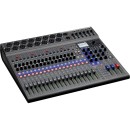
Zoom LiveTrak L-20 |
VS | ||
|---|---|---|---|
| 12-Segment LED | Meters | - | - |
